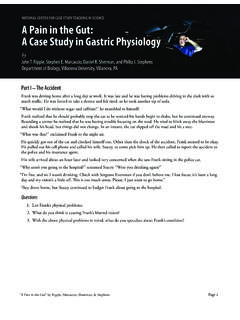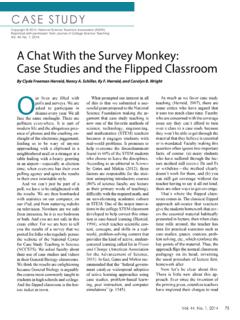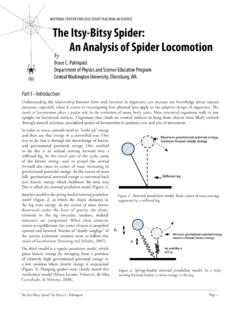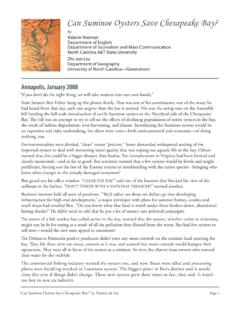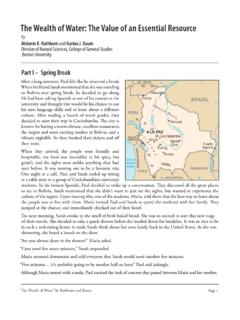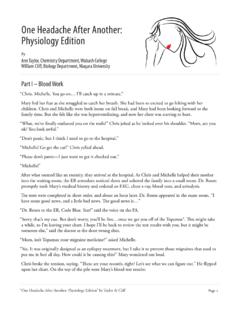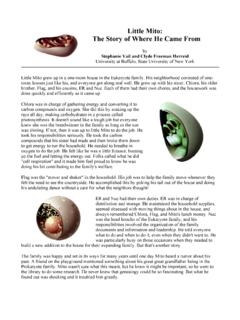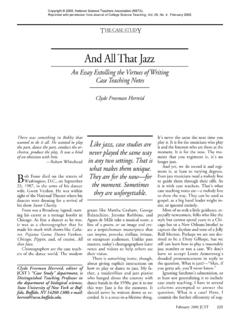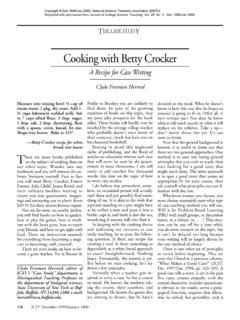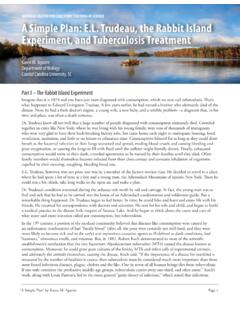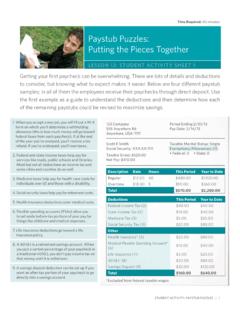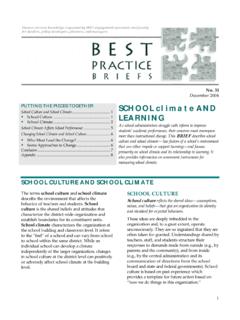Transcription of dna structure flip - Case study
1 Page 1 putting the pieces together by Kevin M. BonneyNATIONAL CENTER FOR CASE study TEACHING IN SCIENCEPart I Setting the StageIn the autumn of 1952, while the weather in London, England, was cooling down, the race to discover the structure of DNA was heating up inside two rival laboratories: the Cavendish Lab at Cambridge University and the laboratory of Randall at nearby King s College. DNA had recently been identifi ed as the hereditary material that organisms use to transmit genetic traits from one generation to another. Th is fi nding is largely attributed to the work of two groups of American scientists, Oswald Avery, Colin MacLeod, and Macyln McCarty of the Rockefeller Institute, and Alfred Hershey and Martha Chase of Cold Spring Harbor Laboratory, though many important experiments conducted by other scientists were crucial to developing this understanding. Th e next great challenge was to identify the structure of DNA so that we could understand how the information contained in DNA is copied and passed from cell to cell, and how that information is translated into the instructions for building the proteins necessary for e groundbreaking research of the Cavendish and Randall laboratories describing the structure of DNA was published in a series of papers in the journal Nature on April 25, 1953 [Wilkins et al.]
2 , 1953; Franklin et al., 1953]. Th ese would become known as some of the most important scientifi c papers ever published, as well as a symbol of great controversy involving allegations of misogyny and ethics violations among scientists who would go on to win a Nobel Prize. Preparing for Your MissionIt s now your job to fi gure out the next piece of the puzzle: How do cells make new copies of their DNA? Before you can fi gure out how DNA is replicated, you must understand the structure of DNA. To prepare for your task, answer the following questions to assess your understanding of DNA structure on your own, without using any outside sources. You will then be asked to view a video. Questions1. Th e structure of DNA is a:A. alpha helixB. single helixC. double helixD. triple helix2. DNA is made of repeating units called:A. amino acidsB. monosaccharidesC. nucleotidesD. peptidesby Kevin M. BonneyLiberal Studies, Faculty of Arts and Sciences New York University, New York, NYPutting the pieces together :The Discovery of DNA structure and ReplicationNATIONAL CENTER FOR CASE study TEACHING IN SCIENCEPage 2 putting the pieces together by Kevin M.
3 Bonney3. Th e D in DNA stands for:A. DarwinB. DeoxyriboseC. DimethylD. Dinucleic acid4. Th e bonds that hold the backbone of each strand of DNA together are called:A. hydrogen bonds B. ionic bondsC. peptide bondsD. phosphodiester bonds5. Th e information contained in DNA is encoded by the:A. hydrogen bonds on the inside of the DNA moleculeB. nitrogenous bases on the inside of the DNA moleculeC. phosphate groups on the outside of the DNA moleculeD. sugars on the outside of the DNA molecule6. In which direction is DNA read?A. 0' to 1'B. 1' to 3'C. 3' to 5'D. 5' to 3'7. Th e letters in the genetic code of DNA are A, C, G, and T. Th e A stands for:A. aminoB. adenineC. alanineD. aspartame 8. If one strand of DNA is AGCTA, the complementary strand would be:A. AGCTAB. ATCGAC. CTAGC D. TCGATW hether you are a DNA novice or a pro, watching the following video should help you put the pieces together . After watching the video, answer the questions again to demonstrate what you know now.
4 You may wish to watch the video more than once before moving on to the e Chemical structure of DNA , and Gosling, 1953. Molecular confi guration in sodium thymonucleate. Nature 171(4356):740 Hughes Medical Institute. Th e Chemical structure of DNA. , , et al. 1953. Molecular structure of deoxypentose nucleic acids. Nature 171(4356):738 CENTER FOR CASE study TEACHING IN SCIENCEPage 3 putting the pieces together by Kevin M. BonneyPart II Discovering the structure of DNATh e story of how DNA structure was discovered is not only one of the most important tales in the history of science, it is also the root of a great controversy that will live on for many years. It is your job to research the collaborations and controversies that made the discovery of DNA structure possible, and determine once and for all who deserves the credit for this groundbreaking feat of science. Th e main characters in the story are named Francis Crick, Rosalind Franklin, James Watson, and Maurice Wilkins.
5 To understand this story, read Watson and Crick s original scientifi c paper: Watson, and Crick, (1953) Molecular structure of nucleic acids; a structure for deoxyribose nucleic acid. Nature. 1953 Apr 25;171(4356):737-8. you have read Watson and Crick s paper, watch this short video to strengthen your understanding of the implications of that work:Th e Secret of Life Discovery of DNA structure . Produced by Virginia Commonwealth University. Running time: 8:36 min. Date: 2014. may also wish to access the following resource for more information:Th e structure of DNA: Cooperation and competition. Understanding Science Team. Th e University of California, Berkeley website. the help of your peers, analyze, evaluate, and debate some of the important ethical implications of the work conducted by Crick, Franklin, Watson, and Why is understanding the structure of DNA and how it is replicated important? List some technologies and practical applications that could not have been developed without this How does the structure of DNA identifi ed by Watson and Crick diff er from the model previously proposed by Linus Pauling and others?
6 3. What discovery by Erwin Chargaff helped Watson and Crick build their model of DNA structure ? How was this piece of information helpful to them?4. What is the main scientifi c weakness you notice in Watson and Crick s paper?5. Th e conclusion of the paper published by Watson and Crick includes the now rather famous statement: It has not escaped our notice that the specifi c pairing we have postulated immediately suggests a possible copying mechanism for the genetic material. Describe what this statement means and why it is signifi cant. 6. Describe the specifi c contribution of each of the following researchers to the discovery of DNA structure : Francis Crick Rosalind Franklin James Watson Maurice Wilkins7. In their paper, how do Watson and Crick acknowledge Rosalind Franklin for her contribution to their work ? 8. Is Watson and Crick s acknowledgement of Franklin satisfactory, or did she deserve more credit? Your instructor will divide you into two groups to debate this question.
7 If you are in the Watson and Crick group, write a one-paragraph argument from their perspective. Defend the way you have treated Rosalind Franklin and provide an argument that you have given her all of the credit she deserves. Support your claims using information from the paper and video you just watched. Prepare to debate your position with members of the other CENTER FOR CASE study TEACHING IN SCIENCEPage 4 putting the pieces together by Kevin M. Bonney If you are in the Franklin group, write a one-paragraph argument from your perspective. Defend yourself against the treatment you received from Watson and Crick, and argue why you deserve more credit for the discovery of DNA structure than you have been given. Support your claims using information from the paper and video you just watched. Prepare to debate your position with members of the other CENTER FOR CASE study TEACHING IN SCIENCEPage 5 putting the pieces together by Kevin M. BonneyPart III Building a Model of DNA ReplicationNow that you can illustrate the structure of DNA and describe the experiments and ethical issues related to its discovery, you are prepared for your mission: To determine how cells make new copies of their DNA.
8 Remember, it is still the 1950s. At this time, three hypothetical models have been proposed to explain how DNA is replicated. Th ese models, known as the conservative model, the dispersive model, and the semi-conservative model, are illustrated in Figure 1. Hypothetical models of DNA the conservative model, both original template DNA strands form one double helix after replication, while the two newly synthesized strands form a second double helix. In the dispersive model, the template DNA is broken into double-stranded segments that act as templates for the synthesis of new double helix molecules; the two resulting double helix molecules each contain half of the original template DNA and half of the newly synthesized DNA. In the semi-conservative model, the original DNA strands are separated, and each acts as a template for the synthesis of a new strand of DNA to complete the double helix. To fi gure out which model of DNA replication correctly illustrates how living organisms make new copies of their DNA, you must fi rst fi nd a way to distinguish the newly synthesized DNA from the original template DNA.
9 Next, you want to fi gure out what would happen in each model and compare that to the actual experimental 1. To start, make a double-stranded DNA molecule to represent the original template DNA. Make each strand of the molecule six nucleotides long, using gumdrops to represent the nucleotides of the original template DNA. Use toothpicks to form bonds that connect the gumdrops in each strand and hold the two strands 2. Choose one model of replication (conservative, dispersive, or semi-conservative) as the mechanism for copying your DNA molecule. From now on use marshmallows to represent newly synthesized DNA and NATIONAL CENTER FOR CASE study TEACHING IN SCIENCEPage 6 putting the pieces together by Kevin M. Bonneytoothpicks to form bonds. Make a copy of the original template DNA molecule by following the principles of the model of replication that you 3. Repeat Steps 1 and 2 for the other two models of DNA 4. Record the percentage of gumdrops and marshmallows in each DNA molecule using the table below.
10 (Divide the number of each by the total number of both and multiply by 100 to calculate the percent.)After one round of replication:ModelDNA molecule ADNA molecule BConservative_____% gumdrops_____ % marshmallows_____% gumdrops_____ % marshmallowsDispersive_____% gumdrops_____ % marshmallows_____% gumdrops_____ % marshmallowsSemi-Conservative_____% gumdrops_____ % marshmallows_____% gumdrops_____ % marshmallowsStep 5. Using only marshmallows and toothpicks, make a copy of each DNA molecule you have from Step 3 following the principles of the three models of 6. Record the percentage of gumdrops and marshmallows in each DNA molecule in the table below. (Divide the number of each by the total number of both and multiply by 100 to calculate the percent.)After two rounds of replication:ModelDNA molecule ADNA molecule BDNA molecule CDNA molecule DConservative_____% gumdrops_____ % marshmallows_____% gumdrops_____ % marshmallows_____% gumdrops_____ % marshmallows_____% gumdrops_____ % marshmallowsDispersive_____% gumdrops_____ % marshmallows_____% gumdrops_____ % marshmallows_____% gumdrops_____ % marshmallows_____% gumdrops_____ % marshmallowsSemi-Conservative_____% gumdrops_____ % marshmallows_____% gumdrops_____ % marshmallows_____% gumdrops_____ % marshmallows_____% gumdrops_____ % marshmallowsQuestions1.
